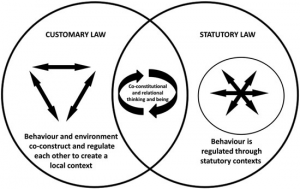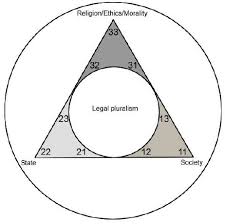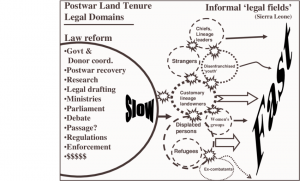Legal pluralism is a concept developed by legal sociologists and social anthropologists “to describe multiple layers of law, usually with different sources of legitimacy, that exist within a single state or society”. It is also defined “as a situation in which two or more legal systems coexist in the same social field”. Legal pluralists define law broadly to include not only the system of courts and judges backed by the coercive power of the state, but also the “non-legal forms of normative ordering”. Legal pluralism consists of many different methodological approaches and as a concept, it embraces “diverse and often contested perspectives on law, ranging from the recognition of different legal orders within the nation-state, to a more far reaching and open-ended concept of law that does not necessarily depend on state recognition for validity. This latter concept of law may come into being whenever two or more legal systems exist in the same social field”.
Legal pluralism has vast policy and governance implications. In developing countries, for instance, non-state justice systems often handle most disputes and retain substantial autonomy and authority. Legal pluralism’s importance, however, is rarely recognized and dramatically under theorized. This article advances scholarly understanding of legal pluralism both theoretically and empirically. It proposes a new typological framework for conceptualizing legal pluralism through four distinct archetypes – combative, competitive, cooperative, and complementary – to help clarify the range of relationships between state and non-state actors. It posits five main strategies used by domestic and international actors in attempts to influence the relationship between state and non-state justice systems: bridging, harmonization, incorporation, subsidization, and repression. As post-conflict situations are fluid and can feature a wide range of relationships between state and non-state actors, they are particularly instructive for showing how legal pluralism archetypes can be shifted over time. Case studies from Timor-Leste and Afghanistan highlight that selecting an appropriate policy is vital for achieving sustainable positive outcomes. Strategies that rely on large scale spending or even the use of substantial military force in isolation are unlikely to be successful. The most promising approaches are culturally intelligible and constructively engage non-state justice networks of authority and legitimacy to collectively advance the judicial state-building process. While the case studies focus on post-conflict states, the theory presented can help understand and improve efforts to promote the rule of law as well as good governance and development more broadly in all legally pluralist settings.
Legal pluralism has occupied a central position in socio-legal theorising from the very beginning of the sociology of law. The sociological theories of Eugen Ehrlich and Georges Gurvitch were early sociological contributions to legal pluralism. It has, moreover, provided the most enduring topic of socio-legal debate over many decades within both the sociology of law and legal anthropology and has received more than its share of criticism from the proponents of the various schools of legal positivism. The critics often ask: “How is law distinguished in a pluralist view from other normative systems? What makes a social rule system legal?”.
The controversy arises mainly “from the claim that the only true law is the law made and enforced by the modern state”. This standpoint is also known as “legal centralism”. From a legal centralist standpoint, John Griffiths writes, “law is and should be the law of the state, uniform for all persons, exclusive of all other law, and administrated by a single set of state institutions. Thus, according to legal centralism, “customary laws and religious laws are not properly called ‘law’ except in so far as state has chosen to adopt and treat any such normative order as part of its own law”.
Legal pluralism has become a major theme in socio-legal studies. However, under this very broad denomination, one can identify many different trends which share little but the very basic idea that law is much more than state law. Despite their eclectic character, these many conceptions of legal pluralism also share some common fundamental premises concerning the nature of law, its function, and its relationship with its cultural milieu. This contribution aims at critically addressing these premises and at suggesting some re-specification of the question of law, its plural sources, and the many practices that enfold in relationship with it. In its spirit, this re-specification can be characterised as realistic and praxiological. Indeed, I shall argue that it is at best useless and at worst wrong to start from a label like “legal pluralism” so as to describe something which is presumed to be an instance of such label. My contention here is that law is what people consider as law, nothing more nothing less, and that occurrences of legal plurality are limited to these situations where people explicitly orient themselves to the fragmented spectrum of law. Instead of looking at the hypothetical pluralistic model of law which something like, e.g., Egyptian law, would be an instance of, the task of social scientists is, rather, to describe the situations, the mechanisms and the processes through which people orient to something legal which they identify as pluralistic. This position is grounded on a principle of indifference, by which one seeks to avoid normative and evaluative engagements: the focus is put on the description of practices, not on their evaluation. Moreover, this position is based on the refusal of any ironic standpoint, i.e. the denial that social scientists occupy any kind of overhanging position vis-a-vis the social, by which they would be entitled to “reveal” to “self-deceived people” the truth which is concealed from them because of their “lack of critical distance”, “ignorance” and/or “bad faith”. In a first section, I shall briefly describe the main trends in the field of legal pluralism, from its historical scientific background to its more recent theories. In a second section, I formulate some of the major criticisms which can be addressed to the postulates sustaining these many versions of legal pluralism. These critical stances vis-a-vis the legal pluralistic study of law articulate around three main questions, i.e. the definitional problem, the functionalist premises, and the culturalist conception which undermine existing theories. I shall argue, in the third section, that realism is a possible remedy to these flaws. However, these are best addressed through what I call a praxiological re-specification of the whole issue of legal pluralism, which I shall illustrate through the study of Egyptian cases. In conclusion, I shall formulate some remarks on praxiology as a way to fill the “missing-what” of classical socio-legal studies.
A distinction is often made between the “weak” and the “strong” versions of legal pluralism. The “weak” version does not necessarily question the main assumptions of “legal centralism”, but only recognises that within the domain of the Western state law other legal systems, such as customary or Islamic law, may also have an autonomous (co-)existence. Thus, the “weak” version does not consider other forms of normative ordering as law. As Tamanaha, one of the critics of legal pluralism, puts it: “Normative ordering is, well, normative ordering. Law is something else, something that we isolate out and call law. The “strong” version, on the other hand, rejects all legal centralist and formalist models of law, as “a myth, an ideal, a claim, an illusion,” regarding state law as one among many forms of law or forms of social ordering. It insists that modern law is plural, that it is private as well as public, but most importantly “the national (public official) legal system is often a secondary rather than the primary locus of regulation”.
The criticism directed at legal pluralism often uses the basic assumptions of legal positivism to question the validity of theories of legal pluralism which aim at criticising those very (positivistic) assumptions. As Roger Cotterrell explains, the pluralist conception should be understood as part of “the legal sociologist’s effort to broaden perspectives on law. A legal sociologist’s specification of law might be different from that presupposed by a lawyer in practice, but it will relate (indeed, in some way incorporate) the latter because it must (if it is to reflect legal experience) take account of lawyers’ perspectives on law. Thus a pluralist approach in legal theory is likely to recognise what lawyers typically recognize as law, but may see this law as one species of a larger genus, or treat lawyers’ conception of law as reflecting particular perspectives determined by particular objectives.
Legal Pluralism Archetypes
This section posits new theoretical archetypes for understanding the fluid relationship between state and nonstate justice in a wide range of settings:
(1) combative,
(2) competitive,
(3) cooperative, and
(4) complementary.
Furthermore, it proposes and examines five main strategies for understanding international and domestic judicial state-builders’ engagement techniques.
The strategies of:
(1) bridging,
(2) harmonization,
(3) incorporation,
(4) subsidization, and
(5) repression.
These strategies illuminate the main domestic and international approaches to engaging the nonstate legal sector in legally pluralist societies.
Combative Legal Pluralism
In combative legal pluralism, state and nonstate systems are overtly hostile to one another. Where the normative underpinnings of the respective legal systems are not even tacitly accepted, the state and nonstate justice sectors seek explicitly to undermine, discredit, supplant, and—ideally—destroy the other. Combative legal pluralism can involve nonstate actors rejecting the state system’s ideological foundation in a largely nonviolent manner. For instance, in the fight against the apartheid state in South Africa, there were active efforts to establish “structures of justice and policing that contested the legitimacy of their equivalent in the apartheid institution” (Nina 2000, 24). While compatible with nonviolence, combative legal pluralism flourishes in countries facing an active insurgency or separatist movement. In many instances, nonstate justice forms a cornerstone of those movements (Mampilly 2011; Arjona, Kasfir, and Mampilly 2015). Unsurprisingly, combative legal pluralism prevails where postconflict state-building has failed or is clearly trending in a negative direction. In many instances, this dynamic coincides with an active insurgency characterized by parallel antagonistic state-building enterprises (Wickham-Crowley 1992; Kalyvas 2006, 218–20). Thus, the scope for even limited collaboration tends to be minimal.
Competitive Legal Pluralism
Competitive legal pluralism, where the state’s overarching authority is not challenged but nonstate actors retain substantial autonomy, characterizes many developing countries and is extremely common after conflict. Indeed, it is the default condition in postconflict settings. While a postconflict political and legal settlement has been reached, it has not yet been consolidated or institutionalized. The prospect of a return to conflict is disturbingly common (Collier, Hoeffler, and Söderbom 2008). The state invariably finds itself trying to assert a new order in places previously beyond its control or in places where that control was contested.7 It is also common in many developing counties where societal actors retain autonomy and still exercise the right to maintain order in a way not dictated by state officials (Migdal 1988). Competitive legal pluralism features significant, often deep, tensions between state and nonstate legal systems, especially where legal norms and procedure diverge significantly (Tamanaha 2008). Yet, in these situations, clashes rarely endanger the state’s formal judicial authority because the nonstate justice sector does not make a concerted effort to supplant state authority entirely. While the nonstate justice sector retains a sizable degree of autonomy, the state and nonstate systems respect each other’s right to exist in some form and are willing to engage with each other, at least tactically (Baker and Scheye 2007).
Competitive nonstate legal systems are most frequently rooted in religious beliefs or shared culture, custom, or heritage. These legal systems often exist outside the state and do not necessarily share the state’s values. Competitive legal pluralism also exists where criminal actors have established separate, parallel orders that rarely seek to take over the state but actively work to retain autonomy by circumventing state law (Volkov 2000). There may be collusion between political elites and criminal actors to evade the law or profit illegally; however, the activities themselves remain fundamentally opposed to state law.
In postconflict settings, the level of competition tends to mirror the success of the state-building process. For example, postconflict state-building efforts in Afghanistan and Timor-Leste both started against a backdrop of competitive legal pluralism. In Afghanistan, where state-building trended in a decidedly negative direction that helped spur renewed violent conflict, competitive legal pluralism has slipped into combative legal pluralism. Alternatively, when the state gains legitimacy, authority, and capacity, the environment and the incentives change, as occurred in Timor-Leste. Nonstate actors increasingly favor collaboration because both the advantages of partnership with the state and the disadvantages of opposing it increase. Nonetheless, as long as nonstate actors retain a high degree of autonomy, the potential for setbacks is ever-present.
Competitive legal pluralism can be prolonged and endemic, particularly when nonstate dispute resolution is seen as legitimate and authoritative. In relatively stable states, it can even be an explicit strategy.8 These difficulties are compounded in postconflict settings where the state’s legal authority and institutions have often been severely compromised.9 While states often seek to supplant nonstate competitors over time, in other circumstances, engagement with nonstate authorities forms the basis of the governance system. Domestic judicial state-builders often rely on powerful, established nonstate actors and structures to support their rule, including but not limited to tribal or clan groups and religious authorities (Migdal 2001).
Cooperative Legal Pluralism
In a cooperative legal pluralist environment, nonstate justice authorities still retain significant autonomy and authority. Nonstate judicial actors, however, have by and large accepted the state’s normative legitimacy and are generally willing to work together toward shared goals. Major clashes are far less frequent and tend to focus on social issues where values clash, such as women’s rights, rather than existential issues of state judicial power. Cooperative legal pluralism tends to thrive in places where progress is being made toward consolidating legitimate state authority. This shift may coincide with meaningful advances toward the consolidation of democratic governance bound by the rule of law. However, the establishment of a high-capacity state that enjoys a cooperative relationship with nonstate authorities does not necessarily require democracy or the rule of law. This dynamic is reflected by postconflict transformations in places like Zimbabwe (Kriger 2006). Yet cooperation has its limits. In many postcolonial African states, nonstate justice actors largely backed the nascent state, but their support often waned “when the state-building project [became] too exclusivist or predatory” (Dorman 2006, 1087).
At the same time, it is important to stress that cooperative legal pluralism is cooperative only in terms of the relationship between the predominant forms of state and nonstate justice. Cooperative legal pluralism does not necessarily mean that, in terms of substance, the law is just. A legal order characterized by this archetype invariably still produces winners and losers. Under cooperative legal pluralism, the law, whether state or nonstate, can still be used to violate human rights, oppress citizens, or perpetrate systematic discrimination against certain groups.
Complementary Legal Pluralism
Legal pluralism does not disappear in a state with a high-capacity, effective legal system, but it is complementary. In other words, nonstate is subordinated and structured by the state because the state enjoys both the legitimacy to have its rule accepted and the capacity to actually enforce its mandates (Ellickson 1991; Mac Ginty 2008, 142). The United States, Western Europe, and many other countries with high-capacity legal systems choose to allow private arbitration, mediation, and other forms of alternative dispute resolution (ADR). ADR takes a wide variety of forms, but “they share the feature that a third party is involved who offers an opinion or communicates information about the dispute to the disputants” (Shavell 1995, 1). For civil disputes, state courts frequently mandate claimants’ attempts to settle their disputes outside of court before being allowed to access state courts (Stipanowich 2004). However, substantively and procedurally, state and nonstate law can still clash. Arbitration agreements facilitate the evasion of state law and legal process, but the extent of circumvention depends on the policy preferences of state officials. In all instances, these processes are integrated into, and fall under the ultimate regulatory purview of, the state, exist at its pleasure, and largely depend on state courts for enforcement. ADR processes are allowed and often encouraged because the state deems them useful for addressing real and perceived “inefficiencies and injustices of traditional court systems” (Edwards 1986, 668).
This form of legal pluralism is complementary from a governance perspective because the state has effectively outsourced alternative forums, such as court-referred mediation, or at least tactically licensed dispute venues, such as binding arbitration. Complementary legal pluralism features a similarly cooperative ethos, but the nonstate justice authorities operate under the umbrella of state authority and without substantial autonomy to reject state decisions. Only complementary legal pluralism can truly uphold that oft-stated requirement for the rule of law: that the law is applied equally to all people (Carothers 1998). Complementary legal pluralism is a worthwhile long-term goal, but it is important to have reasonable expectations about what is feasible in the short to medium term after conflict. As with cooperative legal pluralism, complementary legal pluralism refers only to the nature of the relationship between state and nonstate justice. These types of legal orders canuphold the rule of law, but that does not mean that states with complementary legal pluralism necessarily do uphold the rule of law.



